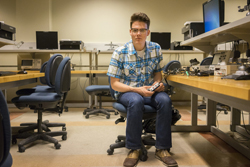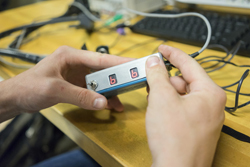Student’s project helps paralyzed uncle, wins honor
LAWRENCE — A stroke in 2002 left Henry Evans a quadriplegic and unable to speak, but his mind was untouched. His nephew, Henry Clever, a senior in the University of Kansas School of Engineering in mechanical engineering, developed a groundbreaking device to help his uncle master his biggest challenges – the ability to communicate and his desire to be independent.
 For more than a decade, Evans used an eye-tracking device that attached to his glasses and transmitted a signal to a computer to compose written correspondence and navigate the Internet. While reliable, this technology has its limitations. The computer must be 2 feet from the user’s face and requires frequent repositioning by a caregiver.
For more than a decade, Evans used an eye-tracking device that attached to his glasses and transmitted a signal to a computer to compose written correspondence and navigate the Internet. While reliable, this technology has its limitations. The computer must be 2 feet from the user’s face and requires frequent repositioning by a caregiver.
Evans – who can move his head and his right thumb – had an idea to develop a new system of sensors that would allow for more freedom of movement and reduce his reliance on others. He called his design the “Ultramouse.” It can be seen in action via YouTube.
 Evans lives near San Jose, Calif., and Clever, from St. Charles, Mo., spent part of summer 2012 in the region for an internship. On a visit from his nephew, Evans shared his idea for the Ultramouse and asked him to see whether he could make it a reality. Clever had another internship that summer in his hometown and used his spare time there to develop the device for his uncle.
Evans lives near San Jose, Calif., and Clever, from St. Charles, Mo., spent part of summer 2012 in the region for an internship. On a visit from his nephew, Evans shared his idea for the Ultramouse and asked him to see whether he could make it a reality. Clever had another internship that summer in his hometown and used his spare time there to develop the device for his uncle.
“I’d work for eight hours a day at my internship, and then I’d come home, write computer code and work on this for another four to five at night in my parent’s basement,” Clever said, joking that he “was kind of a loser that summer.”
It turns out it was quite the opposite. Clever wound up with a design that worked so well that it earned second place in November at the 2013 American Society of Mechanical Engineers International Undergraduate Research and Design Expo in San Diego. Clever was able to set up a Skype connection at the conference so his uncle could participate.
“Overall … it's spot on with what I wanted,” Evans said. “I can now watch YouTube without a computer screen in my face.”
The Ultramouse relies on sensors positioned beside and behind the head, which means it does not require a monitor directly in the line of sight of the person using it or another person to frequently reposition the monitor when the eye tracker connection is interrupted. The system also includes a single-throw push button switch that can be operated by thumb to engage the mouse click. In the event a person cannot manipulate a clicker with their thumb, other options, including a foot pedal, a tongue clickeror head position switch are available.
“Anyone with a debilitating injury most likely can still use head motion and this keys on that,” Clever said. “I think it’s enhanced my uncle’s quality of life.”
Evans said he was impressed with his nephew’s engineering acumen.
“I drew up how I wanted the Ultramouse to work. I first asked a 50 year-old practicing electrical engineer from Silicon Valley to build the electronic control module. He tried for a month, but his device didn't work,” Evans said. “Not only did Henry’s work, it got second place in an international competition. It was great to work with him on this.”
Though Clever developed the Ultramouse in his spare time, he received some basic guidance for his submission in the ASME competition from his academic adviser, Sarah Kieweg, assistant professor of mechanical engineering. Clever works with Kieweg with on a separate research endeavor.
“This is an excellent example of a KU undergraduate student with the motivation and independent initiative to use engineering to improve human health and the successful completion of a very creative device,” Kieweg said.
Clever is due to earn his degree from KU in May and plans to attend graduate school in the fall. He said developing the device and working with his uncle has been a rewarding experience.
“I’m really glad that I’ve been able to do something that’s hopefully made a difference for my uncle. He’s really an amazing guy, and my heart goes out to him,” Clever said. “It’s great knowing that I’ve been able to help improve his quality of life.”